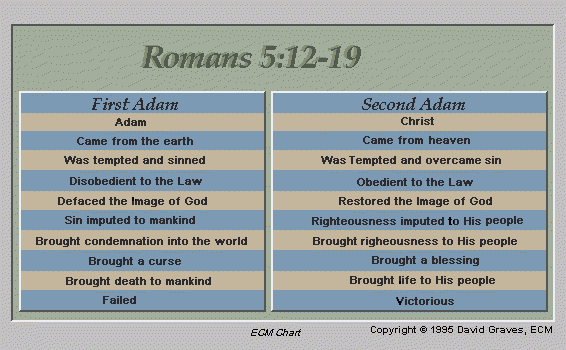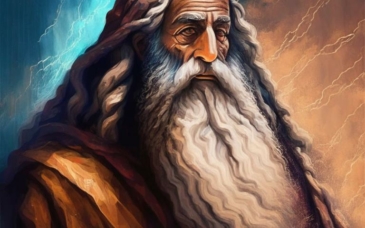Identity of Adam
Adam is from the Hebrew Adam. The word Adam has its Hebrew roots in adamah which means land or ground. The word refers to the rich reddish soil of the fertile crescent in contrast to the arid earth of the wilderness which cannot support life. Usually when it is used in the Old Testament it refers to man generically as in man or mankind. However in Genesis 1-5 it is used as the proper name for the first man, Adam. It is only used for a proper name elsewhere in the Old Testament in 1 Chronicles 1:1; Deuteronomy 32:8; Job 31:33; Hosea 6:7. The interpretation and significance of Adam is left up to the Apostle Paul in the New Testament.
Historicity of Adam and Eve
Adam and Eve are treated throughout the Bible as historical people and not simply as fables, fictional characters or parables of mans moral failure. The author of Genesis goes out of his way to establish the historicity of the account by listing in detail the location of the garden in proximity to the Euphrates and Tigris rivers. Actual conversations are recorded for us and physical descriptions of Adam and Eve are given. (i.e. bones, side, nakedness) Also they both are treated as historical individuals by our Lord Matthew 19:4-6 and New Testament writers Romans 5:12-21; 1 Corinthians 15:22,45; 1 Timothy 2:13,14 and placed in genealogies with other living historical people. 1 Chronicles 1:1; Luke 3:37 There is no doubt that Adam and Eve were historical people who really lived and who really sinned. If Adam is not historical then neither is Christ and our salvation is then nothing more than a myth. If Adam is historical then so is mans sin and the great need for the historical Jesus is emphasised.
Creation of Adam
Body
God created Adam out of the dust of the earth. This shows what man is primarily composed of and what his body returns to at death, dust of the earth. There is allowed here a certain amount of poetic language which in which God is spoken of in terms of a man (anthropomorphic). God does not have hands and it is not meant to show the exact scientific means whereby God created man. Rather it shows the essential substance of mans composition and teaches us his temporal earthiness. The narrative clearly teaches that man is not formed from an inferior creature over time but rather fashioned in his present complexity by the almighty hand of God.
Soul
Then if man remained in this state he would still not be a living body unless God breathes life into man. Literally man became a soul of life or a living soul as God breathed into his nostrils the breath of life. This is used in scripture to refer to the essence of life and death. When breath is removed from the nostrils of man he dies and his body returns to the dust of the earth. Isaiah 2:22 Man needs both body and soul to survive. One without the other is an incomplete and dead man.
Fall of Adam and Eve
The fall of Adam. in disobedience is one of the great failures of humanity. It is recounted for us in Genesis chapter 3. Adam was placed in the Garden which God created and specifically told not to eat of the fruit of the tree of knowledge of good and evil. However the Father of lies, Satan confronts Adam and Eve with the lie that God is the one lying to them. First Satan misrepresents God's words because God did not say that they could not eat of any tree, only that one tree they could not eat of. Eve corrects Satan entering now into a dialogue with Satan and she brings up the issue of death.
Then Satan gives the lie of all lies which he is still using today, you will not surely die. In essence what Satan is saying is that man can live forever if he disobeys God. Eve succumbed to the desires of the flesh and partook of the forbidden fruit and in so doing disobeyed God. She gave some to Adam and the two of them immediately became aware of their own sinfulness and tried to hide in shame. Thus it was that sin entered into the world. It was man's doing not God's.
For Further Study see The Fall
Federal Headship of Adam

The view one takes of Adam colours their view of the rest of the Bible and redemption in general. The place the New Testament places Adam is not simply as the first man but also the representative or head of the whole human race. Romans 5:18 God made an arrangement or covenant with Adam. Genesis 2:15 There was a test of obedience where death was the consequence of disobedience and life for obedience which is implied in the passage. It was also for all of Adams descendants because Adam was the federal head or representative of the whole human race. The consequences of Adams disobedience was imputed to all of man. This is known as the imputation of Adam's sin.
Impute
To reckon, or be counted, to put to the charge of.
- Sin and guilt of Adam is imputed to all of Mankind. Romans 5:12
- The Sin and Guilt of Christ's People was imputed to Christ. 2 Corinthians 5:21
- All the benefits of Christ's life and death are imputed to the Believer.
Second Adam - Christ
The New Testament uses Adam to also refer to Christ in terms of the first and second Adam. Jesus Christ is to act on behalf of His people because He is their head to undo the evil of man which Adam had brought into the world. The Puritans called Jesus the undertaker of our salvation.
Active Obedience
He also undertook to obey all of God's commands and laws to absolute and utter perfection. This is called his active obedience. He is given the privilege of undoing what Adam had done and to regain paradise for us. He was acting on behalf of the New Humanity - His own people.
Passive Obedience
As the Federal head Jesus undertook to absorb the condemnation which His people deserved. His substitutionary death wiped out this condemnation. He liberated them from the condemnation of God. This is what theologians call His Passive obedience - death. However this term can be easily misunderstood and should not be taken as though Jesus was not conscious of what he was doing. He was always aware of his appointed mission and carried it out in perfect obedience to the Father. The term is simply used to contrast it with His earthly ministry.
Eve
Eve comes from the Hebrew name chawwah. It means mother of all the living. Genesis 3:20 She is given the name after the fall and after she is told that she will have pain in bearing children. Before the fall Adam simply called her woman which means taken out of man describing the way she was created. In contrast to Adam Eve was not fashioned from the ground but rather from the side of Adam. This creation was out of God's acknowledgement that it was not good for man to be alone in the Garden. God had created man with the intention of companionship beyond what the animals could offer. There was no help corresponding to Adam in the animals. This underscores the uniqueness of man in contrast to all other created beings. Man is different he is created in God's image.
Eve was created to be a help meet. The woman was specifically created for Adam to meet his need of companionship and social fulfillment not to mention sexual completeness. Having children is not the only reason for getting married.
Eve was created as the help meet but instead became the instrument of the downfall. Paul refers to this order of events to argue for the woman's submission to male headship in the Church. 1 Timothy 2:13,14 Paul clearly shows that the role of women in the Church is an argument based not on culture but creation. It is tied up with the dignity of God's order of creation. Far from degrading women Paul was exalting them by placing them in where God had intended them to exist in prefall Eden. Redemption simply restores us to our original place in God's created order to His glory.



